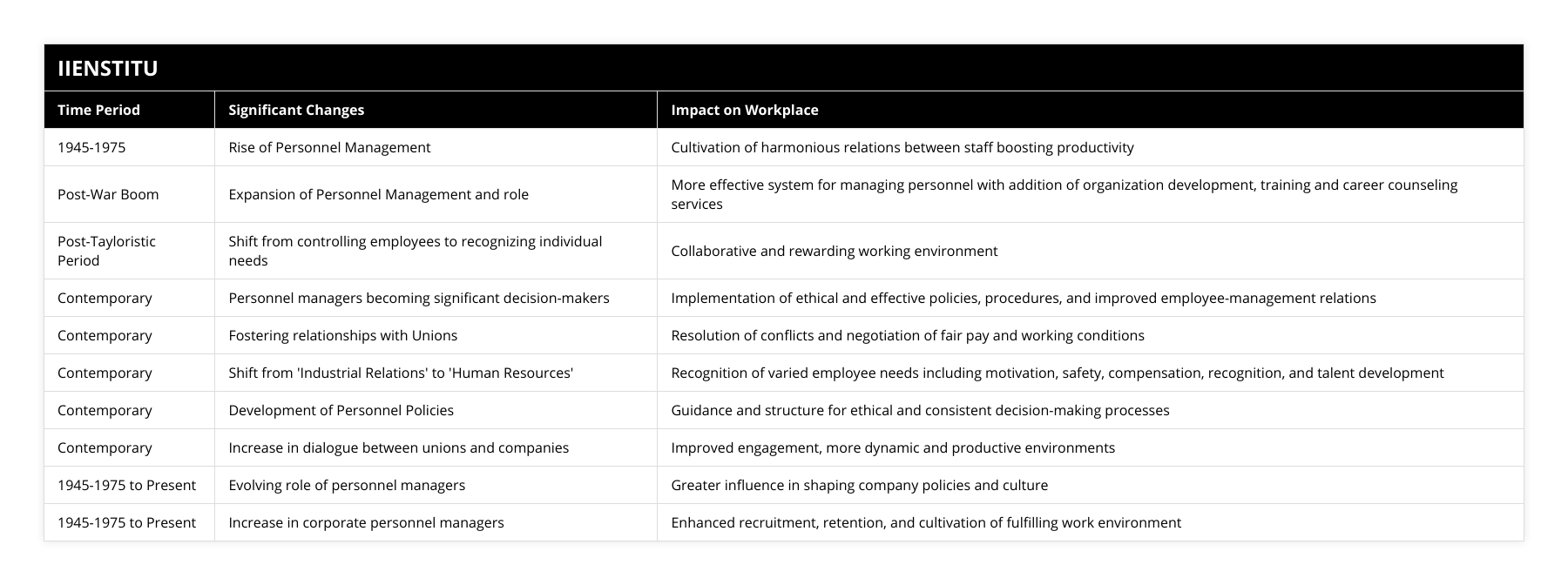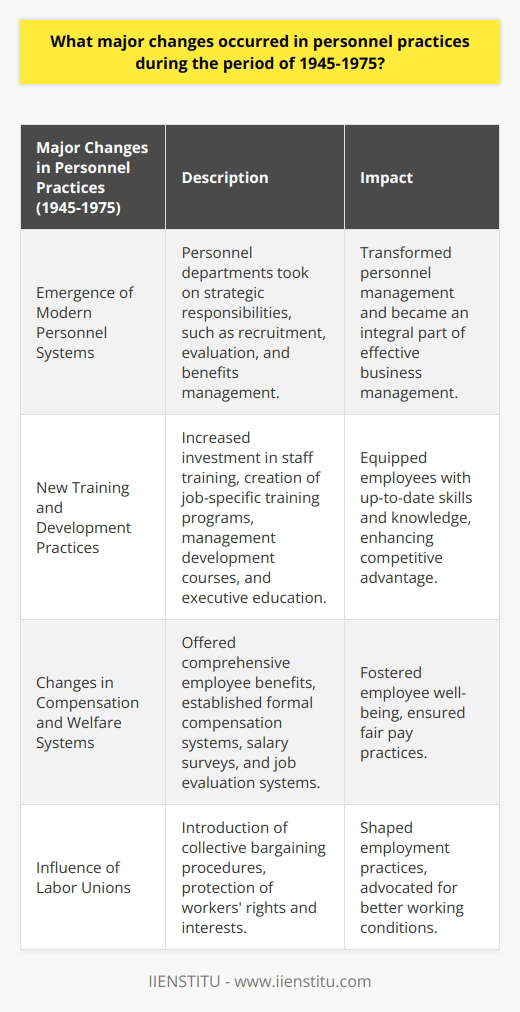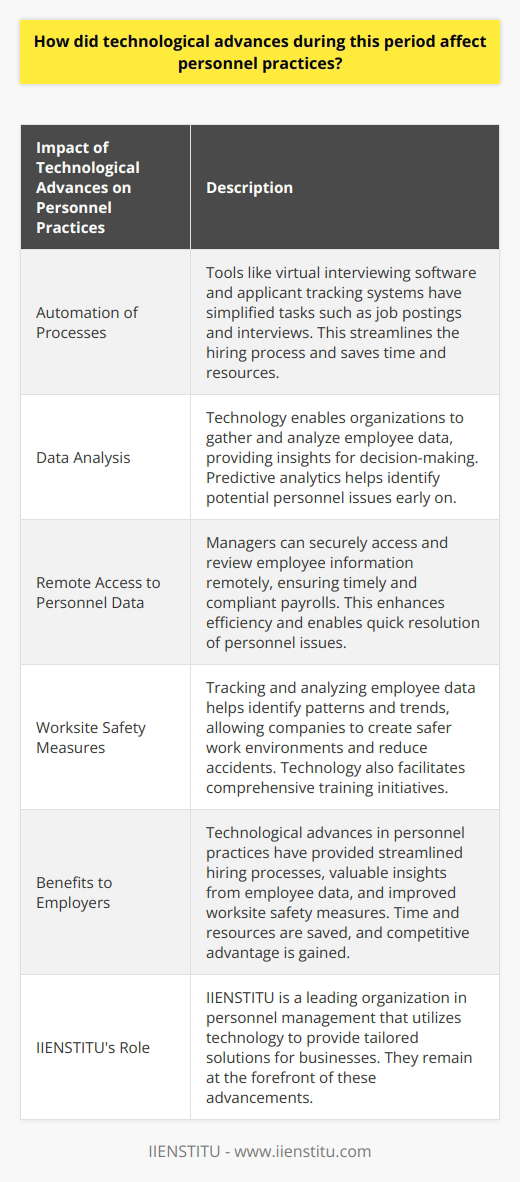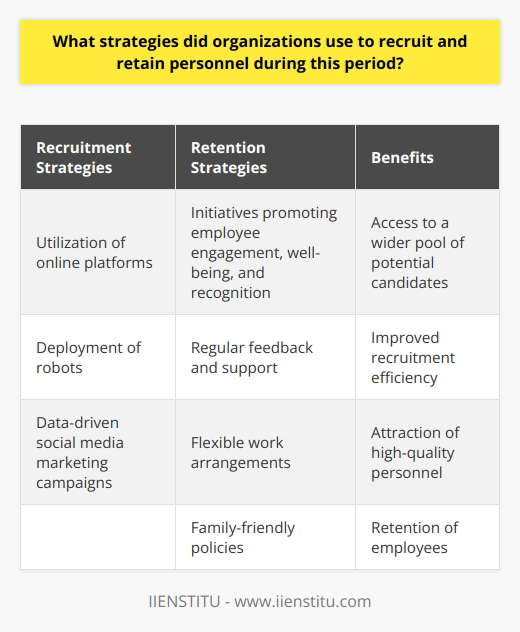
The Evolution of Personnel Management: From Post-War Beginnings to Modern Human Resources
Defining Key Terms
The Rise of Personnel 1945-1975
The challenge to the Tayloristic Approach
Expansion of Personnel Management During the Post-War Boom
Development of Personnel Policies and Processes
I still remember the stories my grandfather used to tell me about his early days working in a factory after World War II. He often spoke about the strict environment, where workers were just cogs in a vast machine, and management rarely interacted with the employees. But over the years, he witnessed a dramatic shift—a rise in personnel managers who began to transform the workplace culture. This evolution not only impacted his life but also reshaped the entire fabric of modern organizations.
Defining Key Terms
Before diving into this fascinating journey, let's clarify some essential terms:
1- Employee Relations: This refers to the communication, direction, and guidance provided by administrative staff to employees. It's all about fostering a positive working relationship between the management and the workforce.
2- Human Resources (HR): The specialized department within a business responsible for personnel management and recruitment. HR handles everything from hiring to training and ensures that the company's human capital contributes effectively to organizational goals.
Perfect Compensation And Benefits Package For Attracting And Retaining Top Talent
Strategic Hr Scorecard To Track And İmprove Workforce Performance Effectively
3- Personnel: Individuals with the qualifications, skills, and experience to manage staff effectively. They are the backbone of any organization, ensuring that both the employees' and the company's needs are met.
The Rise of Personnel Management (1945-1975)
A New Era Post-WWII
The end of the Second World War marked a significant turning point. Countries were rebuilding, economies were shifting gears, and businesses were eager to increase their profits and productivity. In this post-war boom, there was a pressing need to manage the expanding workforce more efficiently and humanely.
Personnel management emerged as a solution. Instead of viewing employees merely as expendable resources, companies began to see the value in nurturing loyalty, trust, and respect. My grandfather often mentioned how the introduction of personnel managers in his factory led to better working conditions and more open communication.
Challenging the Tayloristic Approach
Before this shift, the Tayloristic approach, named after Frederick W. Taylor, dominated management practices. This method emphasized strict control, efficiency, and viewed workers as components in a productivity machine. There was little regard for individual needs or aspirations.
However, with the rise of personnel management:
Employees were seen as human beings with unique skills and potential.
Collaboration replaced rigid hierarchies.
Work environments became more rewarding and supportive.
I recall reading in "Management: Tasks, Responsibilities, Practices" by Peter F. Drucker that this period marked a significant transformation in how organizations perceived their workforce[^1].
Expansion During the Post-War Boom
Meeting the Demands of a Growing Economy
The rapid economic growth demanded more goods and services. Companies recognized that to stay competitive, they needed an effective system for managing their personnel. This realization led to:
1- Organizational Development: Focusing on improving processes and structures within the company.
2- Training and Career Counseling: Investing in employee development to enhance skills and career progression.
3- Recruitment and Selection: Implementing strategies to attract and choose the best talent.
4- Orientation and Induction: Ensuring new employees are well-integrated into the company culture.
I remember my aunt sharing how, during her first job in the 1970s, the presence of a dedicated personnel manager made her transition into the corporate world much smoother.
Personnel and Their Role in the Workplace
Beyond Administrative Tasks
The role of personnel managers has significantly evolved:
Decision-Making Input: They now have a say in strategic planning and organizational decisions.
Policy Implementation: Ensuring that policies are carried out ethically and effectively.
Employee Advocacy: Acting as a bridge between management and staff to address concerns and grievances.
For instance, in my previous job, our HR manager played a crucial role in mediating conflicts and fostering a positive work environment. She ensured that everyone felt heard and valued.
Identifying Workplace Issues
Being in direct contact with employees means personnel managers can:
A rising workforce is a powerful force that can reshape the economic fabric of society.

Spot Potential Problems Early: Addressing issues before they escalate.
Promote a Healthy Work Environment: By understanding staff needs and implementing supportive measures.
Increasing Dialogue Between Unions and Companies
Fostering Mutual Relationships
Personnel management plays a direct role in:
Negotiating with Unions: Developing strategies to resolve conflicts.
Improving Pay and Working Conditions: Ensuring that employee welfare is a priority.
Enhancing Engagement: Open dialogues lead to higher employee satisfaction and productivity.
In "Industrial Relations: Theory and Practice" by Michael Salamon, it's emphasized how effective communication between unions and management has led to more harmonious workplaces[^2].
From Industrial Relations to Human Resources
Embracing a Broader Perspective
The term "Human Resources" began to replace "Industrial Relations", reflecting a broader scope:
Employee Motivation
Workplace Safety
Compensation and Benefits
Staff Recognition
Talent Development
By adopting this new terminology, personnel managers highlighted their critical role in addressing a variety of employee-related issues.
Development of Personnel Policies and Processes
Establishing Trust and Structure
Personnel managers are responsible for creating policies that:
Provide Guidance: Clear protocols ensure everyone knows their rights and responsibilities.
Promote Ethical Decisions: Upholding integrity in all company actions.
Enhance Collaboration: Policies that encourage teamwork and mutual respect.
For example, at my current workplace, the HR department introduced a mentorship program, which has greatly improved inter-departmental collaboration.
The Modern Human Resources Landscape
Adapting to a Changing World
Today's HR professionals face new challenges:
Technological Advancements: Incorporating AI and automation into HR processes.
Remote Work Dynamics: Managing teams spread across different locations.
Cultural Diversity: Navigating the complexities of a global workforce.
In "HR from the Outside In" by Dave Ulrich et al., the authors discuss how modern HR must adapt to external business trends to remain effective[^3].
Personal Experiences in HR Evolution
My Own Journey
Having worked in various organizations over the past decade, I've witnessed firsthand the invaluable role of HR. From helping me navigate a reassignment request letter to providing tips and information on career development, HR professionals have been instrumental in my growth.
Reassignment Request: When I needed to move to a different department, HR guided me through the process, ensuring a smooth transition.
Career Advice: Offering resources and workshops that helped me hone my skills.
The Impact of Personnel Managers Today
Key Contributions
Strategic Partners: HR now contributes to shaping company strategies.
Employee Well-being: Emphasis on mental health and work-life balance.
Cultural Development: Building inclusive and diverse workplaces.
Conclusion
The rise of personnel managers has profoundly shaped organizations over the past decades. From the post-war era's initial steps to today's complex HR landscape, these professionals have transformed how businesses operate. They've moved from administrative roles to strategic partners, ensuring that employees are not just resources but valued members of the organizational family.
As we look to the future, the importance of effective human resource management becomes even more critical. A thriving workforce isn't just about productivity; it's about nurturing a community that can drive innovation and reshape the economic fabric of society.
References
[^1]: Drucker, P. F. (1973). Management: Tasks, Responsibilities, Practices. Harper & Row.
[^2]: Salamon, M. (2000). Industrial Relations: Theory and Practice (4th ed.). Prentice Hall.
[^3]: Ulrich, D., Younger, J., Brockbank, W., & Ulrich, M. (2012). HR from the Outside In: Six Competencies for the Future of Human Resources. McGraw-Hill.
Frequently Asked Questions
What major changes occurred in personnel practices during the period of 1945-1975?
The decades between 1945 and 1975 saw dramatic and wide-ranging changes in personnel practices in many workplaces, particularly in the United States. Existing personnel systems were fundamentally altered, and new rules were introduced and adopted. In addition, this period saw the development of modern personnel departments, further training and development practices, changes in compensation and welfare systems, and the growth of labor unions.
The introduction of modern personnel systems profoundly affected the American workplace. Before 1945, most personnel departments performed mainly record-keeping and payroll functions, with little involvement in recruiting new staff or developing training and development plans. After 1945, personnel departments expanded into more strategic and proactive roles and took on more significant responsibilities. For example, they began recruiting and hiring new staff, administering and evaluating staff performance, conducting training, negotiating collective agreements, and managing employee benefits. Consequently, personnel management emerged as an integral part of successful business management.
The introduction of new training and development practices during 1945-1975 was also significant. Business leaders realized that t maintain competitive advantage, they needed to ensure their employees had up-to-date skills and knowledge. To this end, organizations began investing significantly in staff training, creating new training and development activities, such as job-specific training programs, management development courses, and executive education courses.
In addition to introducing new personnel systems and training and development practices, this period also saw significant changes in compensation and welfare systems. For example, organizations increasingly focused on providing more comprehensive employee benefits like health insurance, life insurance, and retirement plans. There was also an increased emphasis on establishing formal compensation systems, such as salary surveys and job evaluation systems. Moreover, labor unions became more powerful and influential during this time, introducing collective bargaining procedures.
In conclusion, the period between 1945 and 1975 was a significant change in personnel practices. Organizations developed modern personnel departments, introduced a range of new training and development activities, changed how they managed compensation and benefits, and responded to the increasing power of labor unions. These developments significantly impacted how personnel was collected in the years following 1945.

How did technological advances during this period affect personnel practices?
In recent decades, the development of technology has significantly impacted personnel practices in the workplace. Technology has enabled employers to process personnel transactions more efficiently and effectively and streamline data collection and analysis. In addition, with the rise of enterprise-level software systems tailored explicitly to personnel management, organizations can analyze employee data and make decisions based on sophisticated metrics.
Technology-driven personnel practices have focused on automation, where processes like job postings or interviewing can be simplified using tools such as virtual interviewing software or applicant tracking systems. As a result, managers can save time and resources by automating the hiring process while providing more meaningful interaction with candidates. Moreover, organizations can use technology to gain insights into their workforce data and conduct predictive analytics, helping to identify potential personnel issues early on and anticipate necessary actions.
Further, technology has enabled remote access to personnel data, allowing managers to access and review employee and payroll information from anywhere securely. This enables organizations to generate timely and fully compliant payrolls and troubleshoots personnel issues faster. Additionally, by tracking and analyzing employee data, organizations can better deploy worksite safety measures and develop more comprehensive training and professional development initiatives.
Ultimately, technological advances have had a profound impact on personnel practices. Employers have streamlined the hiring process, gained valuable insights from employee data, and generated timely payrolls. In addition, technologies have enabled employers to improve worksite safety and develop more comprehensive training and professional development plans. Technology advances have made personnel practices more efficient, cost-effective, and data-driven, helping organizations better serve their employees and stay competitive in a global climate.

What strategies did organizations use to recruit and retain personnel during this period?
The past few decades have seen a proliferation of strategies to recruit and retain personnel adapted to the ever-changing business landscape. This has been particularly true in times of uncertainty, such as during the Covid-19 pandemic. As organizations adapt to this new reality and plan for future success, they must rely on strategies that best suit their needs.
One primary recruitment strategy is using online platforms to target specific candidates. As a result, organizations can access a much more comprehensive range of potential employees with these technological advances while also considering the job requirements they seek to fill. Additionally, some organizations have deployed robots and data-driven social media marketing campaigns designed to improve efficiency and recruit high-quality personnel.
Regarding retention, organizations have been turning to initiatives focusing on employee engagement, well-being, and recognition. Studies have found that recognition and rewards directly correlate with employee loyalty, which is among the highest predictor of long-term retention. Additionally, providing employees with regular feedback and support can foster trust and community, all of which are integral components of a thriving workforce.
Organizations have also started to invest more heavily in flexible work arrangements such as remote working and implementing family-friendly policies to meet the needs of employees with families. As a result, organizations can create an environment where employees thrive by providing a supportive workplace and allowing for flexibility.
In conclusion, organizations have applied various strategies during this period to recruit and retain personnel; all adapted to the ever-changing business landscape. This includes online platforms, data-driven social media campaigns, and initiatives that focus on employee engagement and recognition. In addition, organizations can improve retention and ensure a healthy and productive workforce by providing employees with support, regular feedback, and flexible work arrangements.

